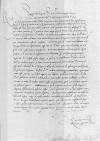List #5691
Sigismund I Jagiellon do Ioannes DANTISCUSCracow (Kraków), 1538-05-05
| odebrano [1538]-06-02 Rękopiśmienne podstawy źródłowe:
| ||||
Tekst + aparat krytyczny + komentarzZwykły tekstTekst + komentarzTekst + aparat krytyczny
Reverendo in Christo Patri, domino
Reverende in Christo Pater, sincere nobis dilecte.
Gratum nobis fuit et iucundum cognoscere ex cf.
Quo die Paternitatem Vestram in viam se dare velimus, iam procul dubio ex his litteris cognovit, quas non ita pridem per cubicularium nostrum misimus. Maturato opus est neque vero dubium nobis est, quo studio et observantia erga nos est Paternitas Vestra, quin cum celeritatis res indigeat, nihil ei sit morae interpositura. Numerum equitum vellemus quidem esse copiosum, sed non tam de apparatu nunc laboramus, quam ut primo quoque tempore negotium hoc confici possit. Quare ne quid ea res profectionem Paternitatis Vestrae retardet, quod si nondum movit se loco, id eam quamprimum facere velimus.
Ceterum si quae apud serenissimum
Illud ante omnia postulamus, ut nihil cunctetur Paternitas Vestra atque id modis omnibus contendat et elaboret, ut serenissimum dominum
Dat(ae) or Dat(um)⌈Dat(ae)Dat(ae) or Dat(um)⌉
Ad mandatum s(acrae) or s(erenissimae)⌈s(acrae)s(acrae) or s(erenissimae)⌉ maiestatis regiae proprium


 BNW, BOZ 953, f. 163v.
BNW, BOZ 953, f. 163v.